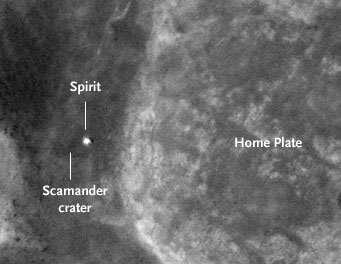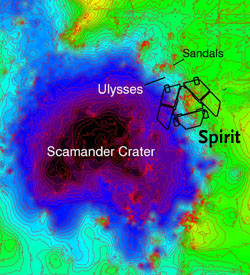Having logged more than 2,000 sols (Martian days) since landing on the Red Planet in early 2004, the rovers Spirit and Opportunity are the Methuselahs of Mars. Next month marks the sixth anniversary of their respective thump-and-roll arrivals at Gusev crater and Meridiani Planum, and they've endured some 23 times longer than than the 90-day missions NASA handlers planned for them.

On June 13, 2009, the HiRISE camera aboard NASA's Mars Reconnaissance Orbiter captured this view of the Spirit rover next to the broad plateau named Home Plate, which is about 300 feet (90 m) across. Click on the image for a larger view.
NASA / JPL / Univ. of Arizona
But while Opportunity continues its long-haul trek to reach a big crater named Endeavour, its twin has been stuck in one spot for six months. Back in May, Spirit was being maneuvered around a low, 300-foot-wide plateau dubbed Home Plate when it broke through a thin crusty layer on the rim of a small crater and sank to its hubcaps in soft dust. NASA engineers have been trying to extricate their six-wheeled explorer ever since.
Spirit's general condition is good, but its prospects for a clean getaway are not. The mission team has found it difficult to mimic how the fine dust behaves in the low gravity and thin atmosphere of Mars. When the rover sank it also bottomed out on a rock that's touching its underbelly.

Spirit is straddling the edge of a small crater dubbed Scamander that contains abundant sulfate minerals. This topographic map was generated from stereo images taken by Spirit's navigation camera when it was approaching the area in April 7, 2009.
Kelly Beatty
The craft's infirmities haven't helped. Its right-front wheel hasn't worked since 2006, failing weeks after reaching Home Plate and forcing the rover to roll backward to get around. Bouts of electronic amnesia come and go, episodes when the computer's flash memory simply fails to record what's going on.
After assessing the situation for many weeks, engineers at the Jet Propulsion Laboratory began a series of carefully designed maneuvers in late November that they hoped would free Spirit from its dusty dilemma. Slowly turning the wheels inched the craft backward a bit, but a new problem arose when Spirit's right-rear wheel abruptly stalled. During a subsequent test a few days later, it stalled again.
The cause isn't yet known, but the most likely reasons are motor failure, a gearbox jam, or a small rock wedged in the wheel — none of which would be good news for the sandtrapped craft. More tests are planned today and tomorrow. "Mars does not owe us a solution to this problem," laments rover driver Scott Maxwell, "and there might not be one."

Spirit spun its wheels (far left) in an attempt to move out of the soft sand where its been trapped for six months. Engineers commanded this maneuver on November 18, 2009, which marked sol (Martian day) 2,091 since Spirit's arrival. These two frames were taken one day before and one day afterward.
NASA / JPL
Meanwhile, all that churning has unearthed a scientific consolation prize. The disturbed soil is enriched in sulfates, in far greater amounts than have been found elsewhere on the planet's surface (which is generally rich in sulfur anyway). "Sulfates are minerals just beneath the surface that shout to us that they were formed in steam vents, since steam has sulfur in it," explains Ray Arvidson (Washington University), a Martian-surface specialist. "Steam is associated with hydrothermal activity — evidence of water-charged explosive volcanism."
In fact, all of Home Plate appears to be an ancient volcanic hotspot, a place where erupting lava came in contact with ice-rich ground and exploded, lofting countless shards of basaltic rock that plopped all over the landscape. In 2007 the rover trudged through a deposit of nearly pure silica, further evidence of volcanic activity.

NASA / JPL
So while everyone would rather have Spirit on the move again, NASA scientists still have plenty to do as the rescue unfolds. "This is some of the best evidence from either rover for past water activity on Mars," Maxwell notes. "From a scientific point of view, it's like having your car break down in front of Disneyland."
 4
4
Comments
Richard Carroll
December 9, 2009 at 3:44 am
Has any thought been given to pressing down on the ground with the arm to help free the rover? Or digging with it? This idea is probably laughable, but I'd like to hear why.
You must be logged in to post a comment.
Nathaniel Sailor
December 13, 2009 at 7:09 pm
To responed to Mr. Carroll, I think the problem you run in to is either the arm isn't strong enough to hold Spirit's weight or the motor for the arm doesn'r enough horsepower to left itself out. I think it's might of been talked about at NASA but I not sure. It's just that is the top two problems I see with the arm.
You must be logged in to post a comment.
Richard Carroll
December 16, 2009 at 1:32 am
Thank you for your comments Mr. Sailor, but I think I mislead you by being overly humble. Of course the problem is the strength of the arm compared to the weight of the vehicle. I'd hoped to hear from someone who has knowledge of those two figures.
Looking at the two pictures of the wheel, apparently a mound of powdery material is cascading down to bury the wheel yet deeper. It's easy to believe that moving the end of the arm horizontally over the mound could scrape off a layer. Advancing deeper as little as a few millimeters at a time looks like it could scrape away the entire mound.
After that, perhaps pebbles could be dropped by the wheel(s) to improve the "roadbed".
You must be logged in to post a comment.
Charles Dostale
December 24, 2009 at 1:24 pm
Check the blog at the Planetary Society -
<http://www.planetary.org/blog/article/00002258/>
You must be logged in to post a comment.
You must be logged in to post a comment.